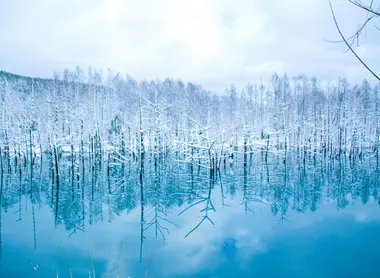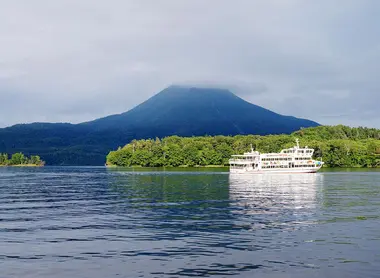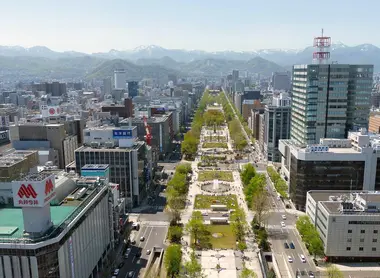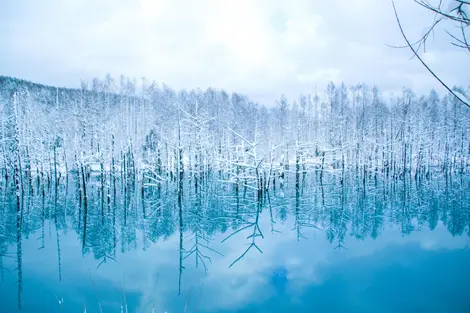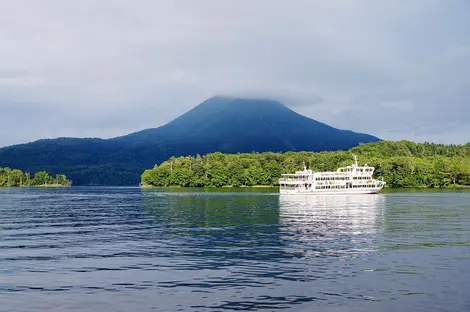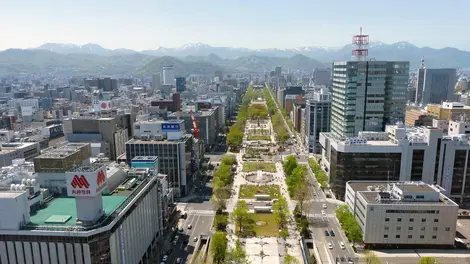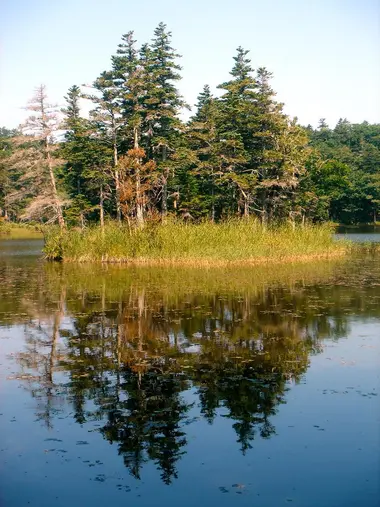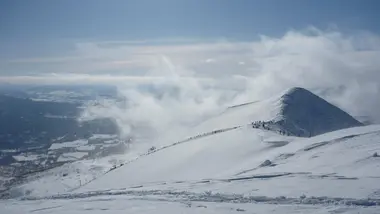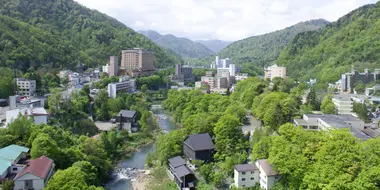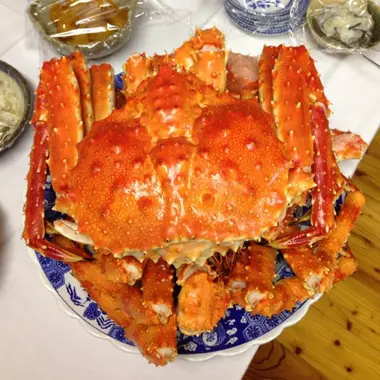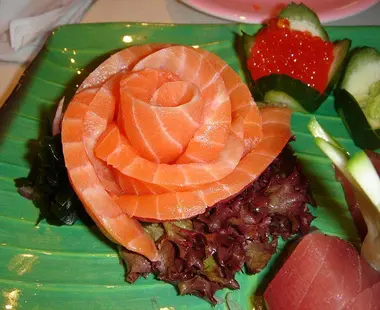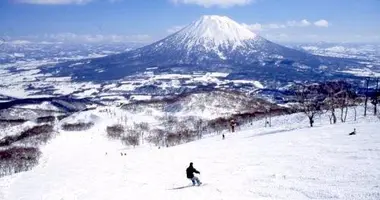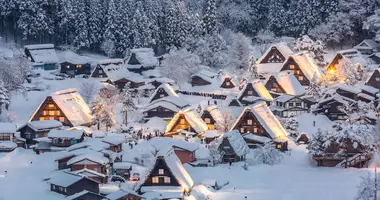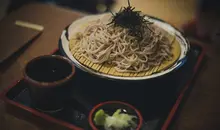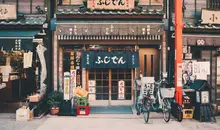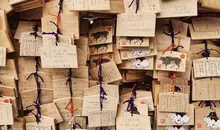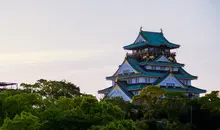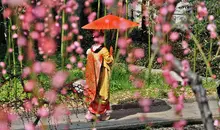Travel to Hokkaido Island
- Published on : 01/10/2020
- by : I.D.O.
- Youtube
The big wild island with grandiose landscapes
The island of Hokkaido, located in northern Japan, offers a radically different face to the Japanese archipelago. Over 70% forested and 15% farmland, this wild region is a nature-lover's paradise. With preserved national parks, active volcanoes, crystal-clear lakes, hot springs (onsens) and exceptional wildlife including brown bears, this land of the Ainu aborigines offers a deep immersion in authentic Japan. Every year, Hokkaido attracts thousands of visitors in search of adventure and a change of scenery, whether in summer to take advantage of cooler temperatures than in the rest of the country, or in winter for the pleasures of the snow.
When to visit Hokkaido The best seasons to visit the island
Hokkaido's climate is marked by distinct seasons, each offering visitors a unique experience. Unlike the rest of Japan, the island enjoys a drier, monsoon-free climate, making it a pleasant destination all year round.
Spring (April to June) is an ideal time to visit Hokkaido. Temperatures are mild, fluctuating between 10°C and 20°C, and nature gradually awakens. Cherry blossoms begin to bloom in late April in Hokkaido, offering a magnificent natural spectacle. This is also the season when the first outdoor activities become available after winter.
Summer (July to September) is Hokkaido's peak tourist season. With pleasant temperatures between 20°C and 25°C, the island becomes an ideal refuge from the stifling heat of the rest of Japan. It's the perfect time for hiking, wildlife watching and discovering Furano's lavender fields and sunflowers in full bloom. It's also the best time to observe wildlife, including bears and whales at Shiretoko.
Autumn (October to November) transforms Hokkaido into a palette of dazzling colors. Forests turn red, orange and yellow, offering spectacular scenery. Temperatures start to drop (5°C to 15°C), but remain pleasant for hiking. This less crowded period allows you to enjoy the sights in a quieter atmosphere.
Winter (December to March) is synonymous with abundant snow and winter sports. Hokkaido is transformed into a veritable white paradise, with temperatures dropping as low as -10°C. Ski resorts such as Furano Ski Resort and Niseko attract winter sports enthusiasts from all over the world thanks to their exceptional powder snow. The famous Sapporo Snow Festival, held in February, is also a not-to-be-missed event.
Must-sees: national parks, lakes and major cities
Hokkaido abounds in natural and cultural treasures well worth exploring. Here are the island's must-see sites:
The national parks
Akan National Park is dominated by the sacred Ainu mountains of O-Akan Dake and Me-Akan Dake. This natural park boasts splendid crystal-clear lakes and hot springs. Lake Akan is famous for its "marimo", spherical green algae unique in the world.
Shiretoko, a UNESCO World Heritage Site, is considered one of Japan's last true wilderness areas. This national park offers breathtaking scenery: hot-water cascades, crystal-clear lakes, wild animals (watch out for bears!). Boat cruises allow you to safely observe brown bears from the sea.
Daisetsuzan National Park, nicknamed the "roof of Hokkaido", is Japan's largest national park. With its majestic mountains, deep valleys and hot springs, it offers an ideal playground for hikers. Mount Asahidake, the island's highest peak at 2290 metres, offers exceptional panoramic views.
Lakes and natural sites
Lake Utonai is a must for migratory birdwatching, with over 250 species recorded.
The lavender fields of Furano are an enchanting sight in summer, with their purple expanses contrasting with the blue of the sky.
The Notsuke Peninsula is an immense 26-kilometer-long strip of sand and land bordering the Pacific Ocean, creating a unique landscape.
Rebun Island, nicknamed "Flower Island", is Japan's last inhabited northern island and offers spectacular hiking.
Mount Apoi, classified as a geopark by UNESCO, is a unique geological site that delights hikers and geologists alike.
The main cities
Sapporo, capital of Hokkaido and Japan's fifth-largest city, is a modern, dynamic metropolis. Founded in the late 19th century, it is known for its famous Snow Festival (Yuki Matsuri), Western architecture and beer. Odori Park, which runs through the city center, is the epicenter of festivities and cultural events.
Hakodate, at the southern tip of the island, is considered the prettiest town in Hokkaido. Its historic port, Western-influenced buildings and panoramic view from Mount Hakodate make it a must-see. The star-shaped fortress of Goryokaku is also a major historical site.
Otaru, a former port town 40 km from Sapporo, is famous for its canal lined with restored brick warehouses transformed into restaurants and boutiques. The town is also renowned for its glass artisans and delicious sushi.
Getting around the island: JR Pass, car rental and public transport
Getting around Hokkaido requires careful planning, as distances between sites of interest can be considerable. Several options are available to travelers:
The Japan Rail Pass (JR Pass) is an economical option for those planning to travel long distances by train. Hokkaido is now linked to the main island of Honshu by the Seikan underwater tunnel and the Shinkansen (high-speed train). The JR Hokkaido rail network serves the island's main cities. However, it is important to note that the network is not as dense as in the rest of Japan, and some remote areas are not accessible by train.
Car rental is often the most practical way to explore Hokkaido, especially if you wish to visit national parks or rural areas. Roads are generally well maintained and signage is clear. In winter, however, you need to be careful as weather conditions can make driving difficult. An international driving license is required to rent a car in Japan.
The bus network complements the rail network and serves many tourist destinations. Express buses connect the main cities, while local buses provide access to more isolated sites. In summer, shuttle services are often organized to facilitate access to national parks.
Domestic flights can be a time-saving option if you wish to visit remote areas. Hokkaido has several regional airports, in addition to New Chitose International Airport (Sapporo).
To optimize your travels, we recommend combining several modes of transport. For example, you can use the JR Pass for long distances between cities, then rent a car locally to explore the surrounding area. In urban areas like Sapporo, public transport (subway, streetcar, bus) is efficient and economical.
Explore Hokkaido's wilderness: hiking, hot springs and wildlife watching
Hokkaido is a paradise for nature lovers and outdoor enthusiasts. The island offers a multitude of experiences to immerse you in its wild and unspoilt landscapes.
Hiking and trekking
Hokkaido's network of hiking trails is extremely diverse, ranging from short walks accessible to all, to multi-day treks for the more experienced. Daisetsuzan National Park, with its many volcanic peaks, offers some of the most beautiful hiking routes in Japan. Mount Asahidake, accessible by cable car, offers spectacular views even for less experienced hikers.
In Shiretoko, the Five Lakes Trail is a popular hike offering a variety of landscapes and perhaps even a glimpse of wildlife. For the more adventurous, the 22 km trek across the peninsula offers total immersion in unspoilt nature.
On the island of Rebun, the Flower Trail reveals a unique alpine flora, with over 300 species of plant, some of which grow nowhere else in the world.
Important tip: when hiking, don't forget to carry a bear bell and follow safety instructions, as Hokkaido is home to a large population of brown bears.
Hot springs (Onsen)
After a day's hiking, what could be more pleasant than relaxing in a natural hot-water bath? Hokkaido is home to a number of onsens renowned for their therapeutic properties.
Noboribetsu Onsen, located in Shikotsu-Toya National Park, is one of the island's most famous spas. Its "Valley of Hell" (Jigokudani) offers an impressive volcanic landscape with fumaroles and bubbling springs.
Jozankei Onsen, easily accessible from Sapporo, is nestled in a picturesque valley and offers a variety of springs with different properties.
For a more intimate experience, the "rotenburo" (open-air baths) allow you to bathe while admiring the surrounding nature, particularly magical in winter when the landscape is covered in snow.
Wildlife watching
Hokkaido is home to a diversity of wildlife that is unique in Japan. The Shiretoko peninsula is one of the best places for wildlife observation. Cruises along the coast allow you to spot brown bears, sika deer, foxes and even whales and orcas, depending on the season.
The Kushiro marshes are Japan's largest wetland and home to the red-crowned crane, an emblematic and protected species. Observatories allow you to admire these majestic birds in their natural environment.
In winter, Siberian Whooper Swans migrate to the lakes of Hokkaido, offering an enchanting spectacle, particularly at Lake Kussharo, where they warm up in the thermal waters that prevent the lake from freezing over completely.
For birdwatchers, Cape Nosappu, Japan's most easterly point, is a prime site for observing migratory birds.
Cultural discovery: Ainu traditions, local gastronomy and unique heritage
Hokkaido has a unique cultural identity within Japan, shaped by its particular history and more recent development than the rest of the archipelago.
Ainu culture
The Ainu ethnic minority, Hokkaido's indigenous people, have developed a rich and distinct culture, in harmony with nature. Long marginalized, the Ainu are now experiencing a revival of interest in their cultural heritage.
To discover this culture, the Porotokotan Museum in Shiraoi offers immersion in a reconstructed traditional village, with demonstrations of dance, song and handicrafts. Wood carvings, distinctive geometric patterns and traditional clothing bear witness to the artistic skills of this people.
Ainu spirituality, based on the veneration of natural forces and animals (kamuy), is reflected in numerous rituals and ceremonies still practiced today. The "iomante", ceremony of the bear spirit, is one of the most important rituals of this culture.
Local cuisine
Hokkaido cuisine is renowned throughout Japan for the freshness and quality of its ingredients. Thanks to its rich waters and vast agricultural land, the island offers a varied and tasty gastronomy.
Seafood is one of the mainstays of local cuisine. Eating crab in Japan is particularly recommended in Hokkaido, where several varieties are available, such as snow crab (zuwaigani) and king crab (tarabagani). Salmon, shrimps, sea urchins and scallops are also unmissable specialties.
Hokkaido is also known for its high-quality dairy products, a rarity in Japan. Locally produced cheeses, ice creams, yoghurts and milk are particularly appreciated for their rich, creamy taste.
Genghis Khan (Jingisukan), the island's signature dish, consists of thin slices of lamb grilled with vegetables on a convex cast-iron griddle. This unique dish reflects the influence of farming practices introduced during the island's modern development.
Sapporo ramen, with its miso-based broth, thick noodles and generous toppings (corn, butter, pork), is one of Japan's most famous ramen variants.For drink lovers, Hokkaido produces excellent craft beers, including the famous Sapporo Beer, as well as internationally award-winning whiskies.
Discover Hokkaido Specialties for a complete overview of this unique regional cuisine.
Historical heritage
Hokkaido's modern history began in earnest during the Edo period (1603-1868), when the Japanese began settling on the island and trading with the Ainu. Colonization then intensified, unfortunately at the expense of the indigenous people.
During the Meiji era (1868-1912), Hokkaido was actively developed to protect the territory from Russian ambitions. The former Hokkaido Prefecture in Sapporo bears witness to this pivotal period.
The Historic Village of Hokkaido (Hokkaido Kaitaku no Mura), near Sapporo, offers a fascinating insight into pioneer life, with its restored period buildings.
In Hakodate, the historic district with its churches, warehouses and Western-style residences illustrates the city's opening up to international trade from the mid-19th century.
Recommended itineraries: 7- to 15-day tours of Hokkaido
To take full advantage of the diversity Hokkaido has to offer, here are a few suggested itineraries for different lengths of stay.
7-day tour: Hokkaido essentials
This compact tour covers the island's major sites in just one week:
- Days 1-2: Sapporo - Explore the capital: Odori Park, Clock Tower, Beer Museum, Nijo Market and the lively Susukino district.
- Day 3: Otaru - Day trip from Sapporo to discover this charming port town and its picturesque canal.
- Day 4: Furano/Biei - Visit the famous flower fields in summer or the ski slopes in winter, with a detour to the blue pond of Biei.
- Day 5: Noboribetsu - Explore the "Valley of Hell" and relax in the hot springs.
- Days 6-7: Hakodate - Discover Mount Hakodate and its panoramic view, the historic district and the Goryokaku fortress.
10-day tour: Nature and culture
This more comprehensive tour adds exceptional natural experiences:
- Days 1-2: Sapporo - As in previous itinerary.
- Day 3: Otaru - Day trip.
- Days 4-5: Daisetsuzan National Park - Hiking in the "garden of the gods" and relaxing in the onsen of Sounkyo or Asahidake.
- Days 6-7: Lake Akan and Ainu culture - Explore Akan National Park, visit the Ainu village and discover the marimo.
- Day 8: Kushiro - Watch Japanese cranes in the marshes.
- Days 9-10: Hakodate - As in previous itinerary.
15-day tour: Grand Tour of Hokkaido
For an in-depth exploration of the island, this comprehensive itinerary will take you to even the most remote areas:
- Days 1-2: Sapporo - Discover the capital and its attractions.
- Day 3: Otaru - Day trip.
- Days 4-5: Furano/Biei - Visit the flower fields and Blue Pond.
- Days 6-7: Daisetsuzan National Park - Hiking and onsen.
- Days 8-9: Shiretoko - Exploration of the national park, wildlife cruise and waterfalls.
- Days 10-11: Lake Akan and Kushiro - Ainu culture and swamps.
- Day 12: Noboribetsu - Hell Valley and onsen.
- Days 13-14: Hakodate - Historic sites and panoramic view.
- Day 15: Return to Sapporo or direct departure from Hakodate airport.
These itineraries can be adapted to suit the season of your visit, with some activities more suited to summer (hiking, wildlife watching) and others to winter (winter sports, snow festival).
To explore more of the natural landscapes of northern Japan, To discover the wonderful landscapes of Hokkaido, book our tour!
Practical advice: budget, accommodation and trip planning
To ensure your trip to Hokkaido runs smoothly, here are a few essential practical tips:
Budget
Hokkaido can be visited on a variety of budgets, but it's important to budget enough to get the most out of the experience:
- Accommodation: Allow around €60-80 for a standard hotel, €30-40 for a youth hostel, and from €150 for a traditional ryokan with meals included.
- Meals: A meal in a family restaurant costs between €8 and €15, while a gourmet meal can easily cost €50 or more.
- Transportation: The JR Pass (approx. 290€ for 7 days) can be worthwhile if you plan to travel a lot. Car rental costs around 50-70€ per day, not including gas.
- Activities: Entrance fees to national parks are generally low (under €10), but experiences such as wildlife-watching cruises can cost between €30 and €80.
For a two-week trip, plan on a minimum budget of €1,500 per person (excluding flights), and more if you wish to stay in ryokans or sample gourmet specialties.
Accommodation
Hokkaido offers a wide variety of accommodation options:
- Ryokans: These traditional Japanese inns offer an authentic cultural experience, with tatami mats, futons, thermal baths and local cuisine. Ideal for immersing yourself in Japanese culture.
- Hotels: Hotels of all categories are available in the main cities. In Sapporo and Hakodate, you'll find international chains and good-quality local hotels.
- Minshuku: A simpler, family-run version of the ryokan, often located in rural areas.
- Hostels and youth hostels: Economical option for travelers on a budget.
- Spa accommodation: In Noboribetsu, Jozankei and other onsen areas, many hotels offer access to thermal baths.
It is advisable to book your accommodation in advance, especially during the peak summer season and popular events such as the Sapporo Snow Festival.
Preparing for your trip
Here are a few tips to help you prepare for your stay in Hokkaido:
- Clothing suited to the season: Temperature variations can be significant. In winter, bring warm, waterproof clothing and non-slip footwear. In summer, light clothing is sufficient, but always bring warm clothing for evenings and mountainous areas.
- Essential accessories: When hiking, don't forget a bear bell, a hat, sun cream and rain gear. In winter, gloves, hat and scarf are a must.
Address, timetable & access
Address
Timetable
Sapporo is served by daily flights from Tokyo and major cities in Japan. Four other airports are scattered from north to south of the island. Hokkaido is also accessible by Shinkansend from Honshu.Access
Sapporo is served by daily flights from Tokyo and Japan's major cities.
Four other airports are scattered across the north and south of the island.
Hokkaido can also be reached by Shinkansen from Honshu.
